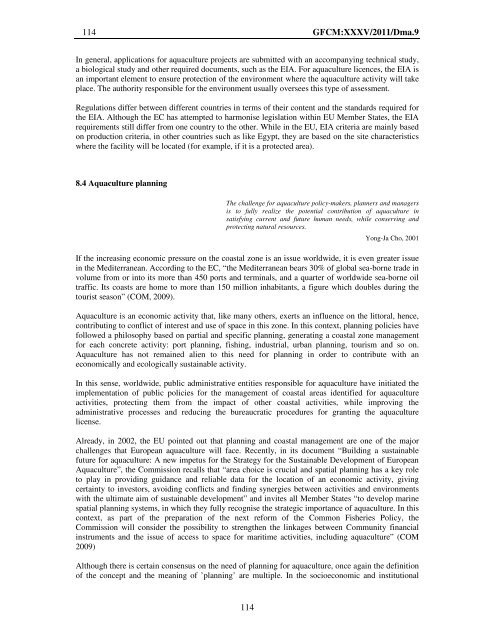Site selection and carrying capacity in Mediterranean ... - FAO Sipam
Site selection and carrying capacity in Mediterranean ... - FAO Sipam
Site selection and carrying capacity in Mediterranean ... - FAO Sipam
You also want an ePaper? Increase the reach of your titles
YUMPU automatically turns print PDFs into web optimized ePapers that Google loves.
114 GFCM:XXXV/2011/Dma.9<br />
In general, applications for aquaculture projects are submitted with an accompany<strong>in</strong>g technical study,<br />
a biological study <strong>and</strong> other required documents, such as the EIA. For aquaculture licences, the EIA is<br />
an important element to ensure protection of the environment where the aquaculture activity will take<br />
place. The authority responsible for the environment usually oversees this type of assessment.<br />
Regulations differ between different countries <strong>in</strong> terms of their content <strong>and</strong> the st<strong>and</strong>ards required for<br />
the EIA. Although the EC has attempted to harmonise legislation with<strong>in</strong> EU Member States, the EIA<br />
requirements still differ from one country to the other. While <strong>in</strong> the EU, EIA criteria are ma<strong>in</strong>ly based<br />
on production criteria, <strong>in</strong> other countries such as like Egypt, they are based on the site characteristics<br />
where the facility will be located (for example, if it is a protected area).<br />
8.4 Aquaculture plann<strong>in</strong>g<br />
The challenge for aquaculture policy-makers, planners <strong>and</strong> managers<br />
is to fully realize the potential contribution of aquaculture <strong>in</strong><br />
satisfy<strong>in</strong>g current <strong>and</strong> future human needs, while conserv<strong>in</strong>g <strong>and</strong><br />
protect<strong>in</strong>g natural resources.<br />
114<br />
Yong-Ja Cho, 2001<br />
If the <strong>in</strong>creas<strong>in</strong>g economic pressure on the coastal zone is an issue worldwide, it is even greater issue<br />
<strong>in</strong> the <strong>Mediterranean</strong>. Accord<strong>in</strong>g to the EC, “the <strong>Mediterranean</strong> bears 30% of global sea-borne trade <strong>in</strong><br />
volume from or <strong>in</strong>to its more than 450 ports <strong>and</strong> term<strong>in</strong>als, <strong>and</strong> a quarter of worldwide sea-borne oil<br />
traffic. Its coasts are home to more than 150 million <strong>in</strong>habitants, a figure which doubles dur<strong>in</strong>g the<br />
tourist season” (COM, 2009).<br />
Aquaculture is an economic activity that, like many others, exerts an <strong>in</strong>fluence on the littoral, hence,<br />
contribut<strong>in</strong>g to conflict of <strong>in</strong>terest <strong>and</strong> use of space <strong>in</strong> this zone. In this context, plann<strong>in</strong>g policies have<br />
followed a philosophy based on partial <strong>and</strong> specific plann<strong>in</strong>g, generat<strong>in</strong>g a coastal zone management<br />
for each concrete activity: port plann<strong>in</strong>g, fish<strong>in</strong>g, <strong>in</strong>dustrial, urban plann<strong>in</strong>g, tourism <strong>and</strong> so on.<br />
Aquaculture has not rema<strong>in</strong>ed alien to this need for plann<strong>in</strong>g <strong>in</strong> order to contribute with an<br />
economically <strong>and</strong> ecologically susta<strong>in</strong>able activity.<br />
In this sense, worldwide, public adm<strong>in</strong>istrative entities responsible for aquaculture have <strong>in</strong>itiated the<br />
implementation of public policies for the management of coastal areas identified for aquaculture<br />
activities, protect<strong>in</strong>g them from the impact of other coastal activities, while improv<strong>in</strong>g the<br />
adm<strong>in</strong>istrative processes <strong>and</strong> reduc<strong>in</strong>g the bureaucratic procedures for grant<strong>in</strong>g the aquaculture<br />
license.<br />
Already, <strong>in</strong> 2002, the EU po<strong>in</strong>ted out that plann<strong>in</strong>g <strong>and</strong> coastal management are one of the major<br />
challenges that European aquaculture will face. Recently, <strong>in</strong> its document “Build<strong>in</strong>g a susta<strong>in</strong>able<br />
future for aquaculture: A new impetus for the Strategy for the Susta<strong>in</strong>able Development of European<br />
Aquaculture”, the Commission recalls that “area choice is crucial <strong>and</strong> spatial plann<strong>in</strong>g has a key role<br />
to play <strong>in</strong> provid<strong>in</strong>g guidance <strong>and</strong> reliable data for the location of an economic activity, giv<strong>in</strong>g<br />
certa<strong>in</strong>ty to <strong>in</strong>vestors, avoid<strong>in</strong>g conflicts <strong>and</strong> f<strong>in</strong>d<strong>in</strong>g synergies between activities <strong>and</strong> environments<br />
with the ultimate aim of susta<strong>in</strong>able development” <strong>and</strong> <strong>in</strong>vites all Member States “to develop mar<strong>in</strong>e<br />
spatial plann<strong>in</strong>g systems, <strong>in</strong> which they fully recognise the strategic importance of aquaculture. In this<br />
context, as part of the preparation of the next reform of the Common Fisheries Policy, the<br />
Commission will consider the possibility to strengthen the l<strong>in</strong>kages between Community f<strong>in</strong>ancial<br />
<strong>in</strong>struments <strong>and</strong> the issue of access to space for maritime activities, <strong>in</strong>clud<strong>in</strong>g aquaculture” (COM<br />
2009)<br />
Although there is certa<strong>in</strong> consensus on the need of plann<strong>in</strong>g for aquaculture, once aga<strong>in</strong> the def<strong>in</strong>ition<br />
of the concept <strong>and</strong> the mean<strong>in</strong>g of ’plann<strong>in</strong>g’ are multiple. In the socioeconomic <strong>and</strong> <strong>in</strong>stitutional
















